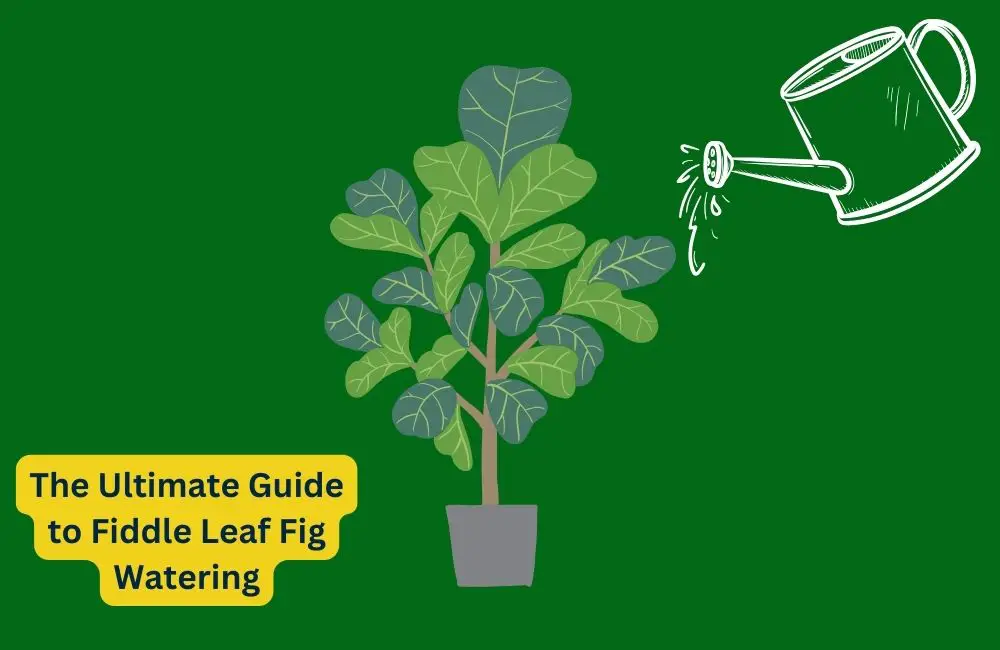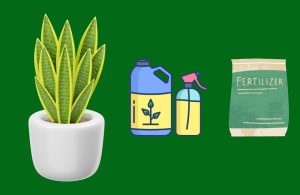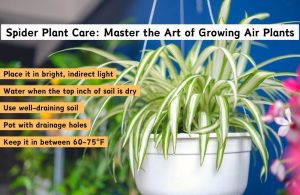This article covers the following areas –
- The Importance of Proper Watering
- How to Water Your Fiddle Leaf Fig
- Signs of Over and Under-Watering
- Advanced Tips for Hydrating Your Fiddle Leaf Fig
- Final Words
Hey there, fellow plant enthusiasts! Today, I’m excited to share everything I’ve learned about watering our beloved Fiddle Leaf Figs. These majestic plants have become a staple in many homes (including mine!) for their striking appearance. However, they’re also known for being a bit finicky, especially when it comes to watering. Let’s dive into the art of keeping these beauties thriving with the proper hydration techniques.
Water Fiddle Leaf Figs when the top inch of soil is dry, approximately every 7-10 days, adjusting for environmental conditions and seasons. Use filtered or rainwater to prevent salt buildup and ensure the pot has good drainage to avoid root rot.
For comprehensive insights into perfecting your Fiddle Leaf Fig’s hydration routine, including the importance of humidity, choosing the proper water, and observation techniques, continue reading our detailed guide.
The Importance of Proper Watering
Proper watering is crucial for the health of Fiddle Leaf Figs, native to tropical rainforests. These plants require consistent moisture and high humidity but cannot tolerate waterlogged soil, which can lead to root rot. Balancing moisture levels is essential for their well-being.
Understanding the unique watering needs of the Fiddle Leaf Fig is key to ensuring its growth and vitality. In their natural habitat, these plants experience periods of heavy rainfall followed by intervals of dryness, allowing them to develop a deep root system while avoiding diseases associated with excessive moisture. Mimicking this cycle in a home environment promotes healthy growth and prevents common issues.
Over-watering is one of the most common mistakes made by plant owners. It not only suffocates the roots by depriving them of oxygen but also creates an ideal environment for fungal infections. Conversely, under-watering can lead to wilted, dry, and brown leaves, as the plant struggles to maintain its lush foliage without adequate hydration.
So, proper watering is not just about the amount of water you give but also understanding the rhythm and needs of your Fiddle Leaf Fig. By paying close attention to your plant’s signals and adjusting your care routine accordingly; you can ensure your Fiddle Leaf Fig remains a vibrant and healthy part of your home.
How to Water Your Fiddle Leaf Fig
To water a Fiddle Leaf Fig, check the soil’s top inch; if dry, water thoroughly until it drains from the bottom. Avoid soggy conditions to prevent root rot. Frequency depends on environmental factors, typically once a week or every 10 days, adjusting for seasonal growth variations.
The Right Technique
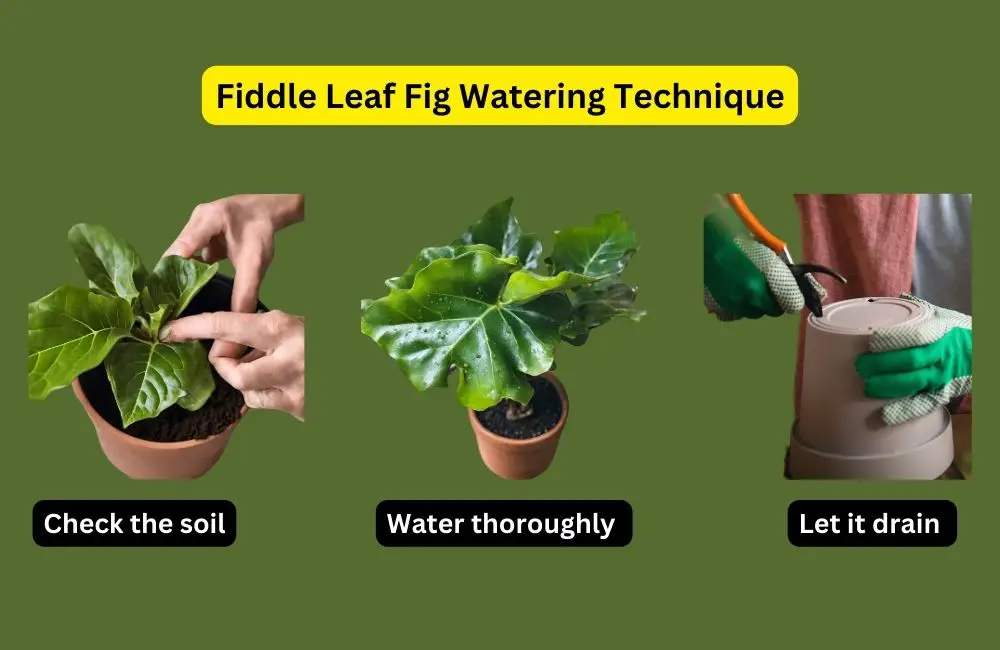
For optimal Fiddle Leaf Fig care, check the soil’s top inch for dryness before watering. Water thoroughly until it drains out the bottom, ensuring even moisture distribution. Avoid letting the plant sit in water to prevent root rot. Adjust the frequency based on environmental factors.
Check the Soil:
Think of this as the first date with your plant: you’re getting to know each other. Gently probe the soil with your finger. If the top inch feels like a dry summer day, it’s time for a drink. But if it’s more like a damp morning, wait a bit longer.
Water Thoroughly:
Imagine you’re creating a gentle rain for your plant. Pour water evenly around the plant, letting it soak the soil until it starts to escape through the drainage holes. This method ensures every part of the root system gets hydrated, just like a refreshing shower.
Let it Drain:
No plant likes wet feet! Ensure your pot has good drainage and allow the excess water to escape freely. This step is crucial for avoiding the dreaded root rot, giving your plant the perfect environment to flourish.
Frequency and Timing
Water Fiddle Leaf Figs based on soil dryness, typically once every 7-10 days, adjusting for seasonal growth and home environment factors. In warmer months, increase frequency; reduce in cooler, dormant periods. Always check the top inch of soil to guide watering needs.
Environmental Factors:
Your home’s environment significantly affects how quickly your Fiddle Leaf Fig uses water. Factors such as air circulation, light levels, and temperature can either speed up or slow down the rate at which the soil dries out. For instance, plants placed in bright, sunny spots or rooms with dry air may need more frequent watering than those in cooler, shaded areas.
Plant Size and Potting:
The size of your Fiddle Leaf Fig and the type of pot it’s in also influence watering needs. Larger plants in porous pots, like terracotta, tend to dry out faster than smaller plants in plastic or glazed ceramic pots. It’s essential to consider these variables when determining how often to water your plant.
Seasonal Adjustments
Adjust watering for Fiddle Leaf Figs seasonally: increase during spring/summer growth phases and decrease in fall/winter. Monitor soil moisture closely and modify watering frequency to match the plant’s reduced growth and hydration needs during cooler, less active periods.
Spring and Summer:
During the active growth period in spring and summer, your Fiddle Leaf Fig will likely require more water to support the development of new leaves and branches. This is the time to be more vigilant about checking the soil moisture and possibly increasing your watering frequency to accommodate the plant’s higher hydration needs.
Fall and Winter:
As the days get shorter and temperatures drop in fall and winter, your Fiddle Leaf Fig will enter a dormant phase, slowing its growth. This reduced activity level means the plant will use water more slowly, requiring less frequent watering. It’s a good practice to let the soil dry out a bit more than usual before watering during these cooler months to prevent over-watering and root rot.
By fine-tuning your watering routine to align with the specific needs of your Fiddle Leaf Fig throughout the year, you can ensure your plant remains healthy and vibrant, regardless of the season. Remember, the key to successful plant care is observation and adaptation, paying close attention to the subtle cues your plant gives you.
Signs of Over and Under-Watering
Signs of over-watering in Fiddle Leaf Figs include yellowing leaves, leaf drop, and root rot. Wilted, droopy leaves and brown, crispy edges or spots indicate underwatering. Monitoring these signs is crucial for adjusting watering practices to maintain plant health.
Over-Watering

When your Fiddle Leaf Fig starts to look more like a weepy willow, it’s a clear sign that you might be loving it a bit too much, at least in the water department. Over-watering is a common issue, especially for those who want to make sure their green friend is getting enough to drink. Here’s what to watch out for:
- Yellowing Leaves: The first red flag. Leaves turning yellow and falling off are not just part of a natural cycle; they’re your plant’s way of telling you it’s in distress.
- Root Rot: This is a more severe consequence of too much water. If the roots are drowning, they can’t breathe, leading to decay. This condition can be fatal if not addressed quickly.
- Mushy Stems or Leaves: Over-watering can cause the plant’s stems or the base of the leaves to feel mushy or soft, a sign of waterlogged tissue.
Reducing your watering frequency and ensuring your pot has adequate drainage are key steps to remedy over-watering. It might also help to repot your plant in fresh, well-draining soil to give it a fresh start.
Under-Watering
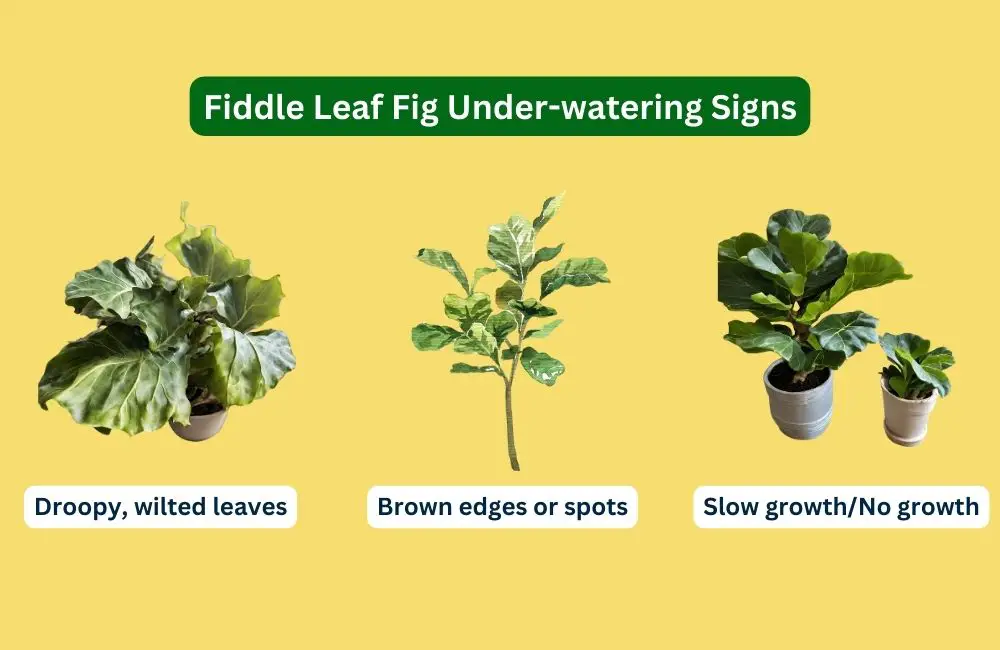
Conversely, under-watering can leave your Fiddle Leaf Fig sending out distress signals, looking sad and neglected. Here’s how to tell if your plant is thirstier than you thought:
- Droopy, Wilted Leaves: Leaves that look defeated and droopy clearly indicate that your plant needs more water. They may also feel dry to the touch.
- Brown Edges or Spots: These are akin to the plant’s cry for help, signaling that it’s not getting enough moisture to keep the leaves healthy and hydrated.
- Slow Growth or No Growth: If your Fiddle Leaf Fig has stopped growing or the new leaves are coming in small, it could be a sign that it’s not getting enough water to support growth.
To combat under-watering, gradually increase your watering frequency, but be careful not to swing too far the other way and over-water. A consistent check of the soil moisture can guide you to find the right balance.
Over and under-watering can be corrected with careful observation and adjustments to your watering routine. Remember, it’s all about finding that sweet spot where your Fiddle Leaf Fig feels just right, mimicking the natural environment in which it thrives.
Advanced Tips for Hydrating Your Fiddle Leaf Fig
Taking care of a Fiddle Leaf Fig isn’t just about sticking to a watering schedule; it’s about creating the perfect environment for your leafy friend to flourish. Beyond the basics, a few advanced tips can help you elevate your plant care game. From tweaking the humidity levels to choosing the right type of water, these tips will help you cater to the nuanced needs of your Fiddle Leaf Fig. Let’s dive into these pro-level strategies to ensure your plant thrives.
The Role of Humidity
Fiddle Leaf Figs are tropical plants at heart, which means they love a humid environment. Here’s how you can boost the humidity around your plant:
- Misting: A quick spritz of water on the leaves can increase the humidity level, mimicking the moist air of its natural habitat. It’s like giving your plant a mini tropical vacation.
- Pebble Tray: Place a tray filled with pebbles and water beneath the plant’s pot. As the water evaporates, it increases the moisture in the air around the plant.
- Grouping Plants: Placing several plants together can create a microclimate with higher humidity, benefiting all the plants.
Choosing the Right Water
The quality of water can have a surprising impact on the health of your Fiddle Leaf Fig. Here’s what to consider:
- Tap Water: If your tap water is hard, it might contain minerals that can accumulate in the soil, potentially harming your plant. It might be time to switch if you notice a white buildup on the soil or pot.
- Filtered or Rainwater: These are gentler on your plant, helping you avoid the potential issues that come with tap water. Collecting rainwater can be a simple and eco-friendly option.
Observing and Adjusting
The secret to mastering Fiddle Leaf Fig care lies in being attentive and flexible. Here’s how to fine-tune your approach:
- Monitor Your Plant: Monitor how your plant responds after watering and note any changes in the leaves or growth patterns.
- Adjust Based on Feedback: If you notice signs of distress, consider adjusting your watering frequency, the amount of water, or even the water type.
- Be Patient: Sometimes, it takes a bit of trial and error to get it just right. Plants can slowly show improvement, so give them time to adjust.
By incorporating these advanced hydration tips into your care routine, you can create a thriving environment for your Fiddle Leaf Fig. Remember, the goal is to mimic the natural conditions as closely as possible, and with a little extra attention to detail, you’ll be rewarded with a healthy, happy plant.
Final Words
Watering your Fiddle Leaf Fig doesn’t have to be a source of anxiety. With some knowledge and attention to your plant’s needs, you can master the art of hydration. Remember, it’s all about understanding the signs your plant gives you and responding with love and care. Happy watering!
Remember, every Fiddle Leaf Fig has its personality, and part of the joy of plant care is getting to know what makes each one thrive. I hope this guide helps you on your journey to becoming a Fiddle Leaf Fig whisperer. Cheers to happy, healthy plants!

